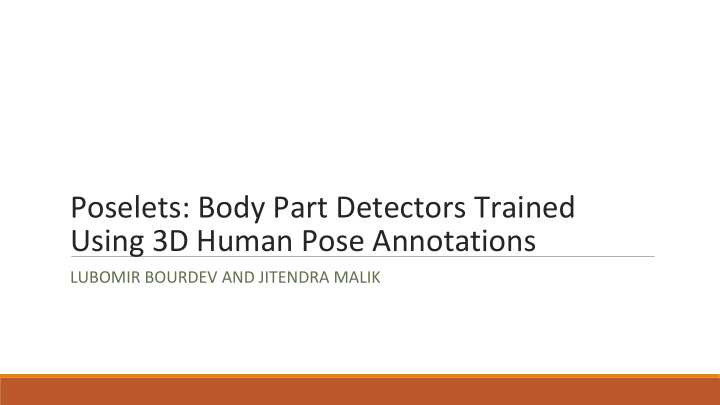



Poselets: Body Part Detectors Trained Using 3D Human Pose Annotations LUBOMIR BOURDEV AND JITENDRA MALIK
Outline H3D dataset Pipeline Analysis of Poselets fired Selective parts – torso, legs and face Other cases – Clutter, Rotation and Occlusion Analysis of Hough Transform Conclusion
Outline SVM 1 SVM 2 Localized Hough Transform object SVM 3 SVM n
H3D dataset
Original Image Given an image, use SVM's trained for ~300 poselets to get poselet activations
Poselet Activation Clusters Using the H3D training set we fit the transformation from the poselet location to the object. Cluster the hypothesis using KL divergence
Poselet Activations Run each poselet detector at every position and scale of the input image, collect all hits and use mean shift to cluster nearby hits.
Object Localization Find peaks in Hough space by clustering the cast votes using agglomerative clustering and compute the sum over the poselets within each cluster
Object Hits All the clusters in terms of image patches
Poselets Poselet Activations for the last matches Poselet Activations for the best match
Experiment Setup Available code - takes an image and draws the bounding box on the subject Uses a pretrained model for poselets which is used to fire on images and generate hypothesis from 3-D space to 2-D space Uses a pretrained model for weights of different poselets which is used to combine the probability of object location corresponding to the poselet
Test Cases Good localization examples Different poselets which are activated Change in subject conditions Training Data and Analysis of Hough transform space
What works Good quality of bounds on the subject High score – support from a good number of poselets Poselets corresponding to head and whole body Different scales
Part poselets Poselets when only certain part of body is seen in the image Poselets corresponding to the part should contribute the most towards the score
Face Poselets
Torso Poselets
Lower body Poselets Best match
Lower body Poselets Second Best match
Image Conditions Look at the performance of poselets in presence of different image conditions like Clutter, Rotation and occlusion
Clutter Good detection in presence of clutter. Poselets corresponding to lower body and the whole body contribute the most in localization
Extreme Rotation Best match – incorrect localization False positives – Decent Poselets corresponding to face fired localization but votes from on this incorrect poselets
Occlusion Tenth match with score= 0.42 Highest Match = 0.82
Analysis of Hough Transform Look at the peaks generated in the Hough space Each peak corresponds to an image patch localizing the object Votes from poselets for the image patch vote for the plausible object location Votes in Hough space clustered using agglomerative clustering
Analysis of Hough transform Score = 0.69
Score = 0.31
Poselet activation with highest score = 0.18
Poselet activations which would lead to good localizations with score ~0. 10
Limited Training Data?
Score = 1.10 Though the score of best match is low, none of the poselets fired are on the subject. Instead objects are detected in the background
Training Data ~1500 annotated images Many images have people upright or facing the camera The limitations in previous slides can be solved by adding more training data for different postures where poselets other than face, whole body and legs are fired Difficult to generate annotated data?
Conclusion Current methods like R-CNN perform exceptionally well for person category compared to poselets If we take into account the amount of training data used then poselets fares well However from experiments though the image patch obtained is of considerable quality the poselet activations corresponding to the patch is not right in terms of the structure, scale and orientation in many cases
References Poselets: Body Part Detectors Trained Using 3D Human Pose Annotations - Lubomir Bourdev and Jitendra Malik Rich feature hierarchies for accurate object detection and semantic segmentation - Ross Girshick, Jeff Donahue, Trevor Darrell, Jitendra Malik
Recommend
More recommend